(Every now and then a garden blogger has to narrow down his or her focus and talk to the locals, and so this posting is probably aimed at gardeners on the east coast of Australia more than anywhere else right now, but I guess it applies to anywhere when the rain doesn't stop, the humidity rises and the vegie patch takes on a grey dusting of powdery mildew disease....)
Powdery mildew. It attacks all sorts of plants. I was even reading about it attacking mighty oak trees earlier today. It's a fungal disease that's like having zillions of tiny white mushrooms infesting the leaves on your plants. It looks like the foliage has been dusted with talcum powder. (But unlike Ogden Nash's lovely little rhyme that: "A little bit of talcum is always walcum", a little bit of powdery mildew is never really walcum in the garden.)
Of all the plants it attacks, powdery mildew loves the vegie patch most: zucchinis, cucumbers, pumpkins, squash and melons are its classic victims, but it attacks many others, too. Well, I think I have found an organic product that works very well to control powdery mildew, isn't too much of a hassle to use, and is worth mentioning here. And no, this isn't a paid ad, as you (and its makers) will soon discover.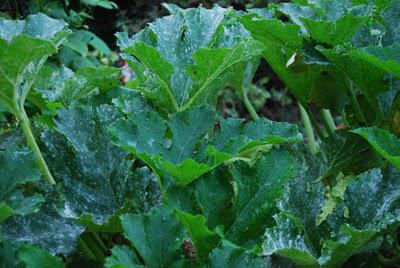 Here's my zucchini plant from last summer, its leaves dusted with powdery mildew. It's the white stuff. It doesn't actually kill your crop. You still get zucchinis coming through in droves, but upstairs the plant looks dreadful. And I like pretty plants, so this bothers me. When powdery mildew gets really bad, it can harm plants' health and shorten their season.
Here's my zucchini plant from last summer, its leaves dusted with powdery mildew. It's the white stuff. It doesn't actually kill your crop. You still get zucchinis coming through in droves, but upstairs the plant looks dreadful. And I like pretty plants, so this bothers me. When powdery mildew gets really bad, it can harm plants' health and shorten their season.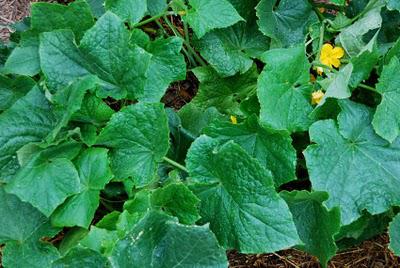 Sydney has had a ridiculous amount of rain recently, and this cucumber plant has no reason to look this healthy, and that is due to the product which I'll tell you about a bit later on.
Sydney has had a ridiculous amount of rain recently, and this cucumber plant has no reason to look this healthy, and that is due to the product which I'll tell you about a bit later on.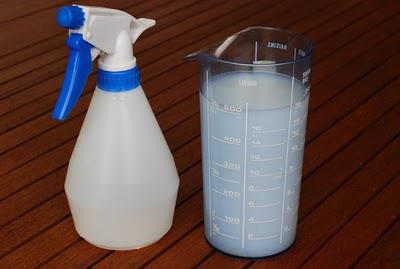 No, this isn't it, but it is one organic solution that is sort-of worth a try. It's milk, diluted 1:10 with water, and used as a spray. If you do a Google search you'll find a fair bit of literature saying it works. I have tried it for two years and it just barely works. You need to re-apply it constantly, especially after every shower of rain. So it's a pain to use, as it's so much work. And if powdery mildew sets in for any reason (ie, you have a weekend away), it cannot stem the tide. As far as I am concerned, it's not all that effective, but it's not hopeless, either.
No, this isn't it, but it is one organic solution that is sort-of worth a try. It's milk, diluted 1:10 with water, and used as a spray. If you do a Google search you'll find a fair bit of literature saying it works. I have tried it for two years and it just barely works. You need to re-apply it constantly, especially after every shower of rain. So it's a pain to use, as it's so much work. And if powdery mildew sets in for any reason (ie, you have a weekend away), it cannot stem the tide. As far as I am concerned, it's not all that effective, but it's not hopeless, either.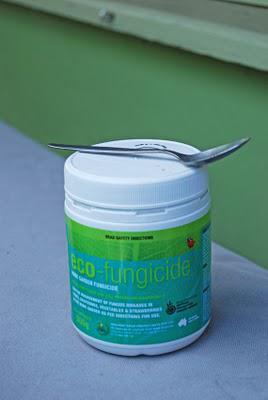 This is what's working for me this time round. The mob who makes Eco Fungicide also makes Eco Rose, Eco Oil and a range of other certified-organic 'Eco' products. To be unfair, it's a glorified bi-carb soda mixture, but I have tried the home-made bi-carb soda recipes and this one works better than them. There must be something else in it, but I'm not sure what it is (EDIT! See Alexa's comment below – it's potassium bicarbonate, not the common kitchen stuff sodium bicarbonate – thank you Alexa). It's not cheap, but one 500ml jar should last me several years, at the tiny rate at which I use it in my small garden. This 500g container cost $19.85 at Bunnings (our mega hardware chain, for overseas readers).
This is what's working for me this time round. The mob who makes Eco Fungicide also makes Eco Rose, Eco Oil and a range of other certified-organic 'Eco' products. To be unfair, it's a glorified bi-carb soda mixture, but I have tried the home-made bi-carb soda recipes and this one works better than them. There must be something else in it, but I'm not sure what it is (EDIT! See Alexa's comment below – it's potassium bicarbonate, not the common kitchen stuff sodium bicarbonate – thank you Alexa). It's not cheap, but one 500ml jar should last me several years, at the tiny rate at which I use it in my small garden. This 500g container cost $19.85 at Bunnings (our mega hardware chain, for overseas readers).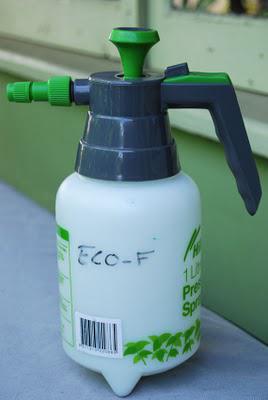 For each spray I use here (and there aren't many) I allocate a cheap pump sprayer, and never mix anything else in it. You can't store a mixture of Eco Fungicide for any time, so you just mix up a batch and use it all, each time. For this one-litre bottle of water, I add one level teaspoon of Eco Fungicide powder, plus 2mL of horticultural oil.
For each spray I use here (and there aren't many) I allocate a cheap pump sprayer, and never mix anything else in it. You can't store a mixture of Eco Fungicide for any time, so you just mix up a batch and use it all, each time. For this one-litre bottle of water, I add one level teaspoon of Eco Fungicide powder, plus 2mL of horticultural oil.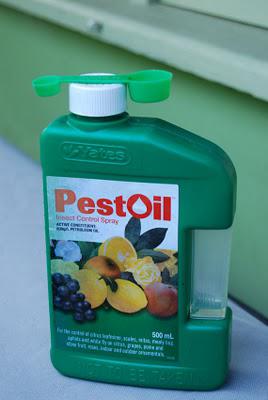 If the people who make Eco Fungicide were thinking this is a great free plug for them, they'll be horrified to see the opposition's product here! Eeeek! The Eco Fungicide people make Eco Oil, which is a vegetable based, organic horticultural oil. The opposition product, PestOil, is petroleum-based, but it's a very very mild oil that does an almost identical job to Eco Oil, and it's what I use, and what I have a 500ml bottle of already. And I only need a tiny bit, so it'll do me, as it always has done. Fab product, PestOil.
If the people who make Eco Fungicide were thinking this is a great free plug for them, they'll be horrified to see the opposition's product here! Eeeek! The Eco Fungicide people make Eco Oil, which is a vegetable based, organic horticultural oil. The opposition product, PestOil, is petroleum-based, but it's a very very mild oil that does an almost identical job to Eco Oil, and it's what I use, and what I have a 500ml bottle of already. And I only need a tiny bit, so it'll do me, as it always has done. Fab product, PestOil.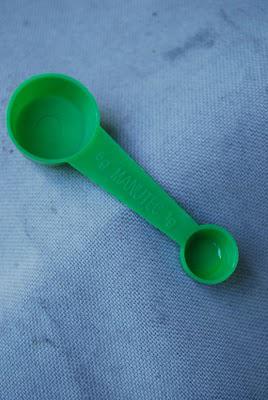 As for only needing a tiny bit, this is where my policy of "never throw out a measure of any sort" came into its own. Isn't hoarding great when it pays off? Yippeee! Anyway, this is a measure from an old packet of trace elements, and this little 1mL cup-ette is perfect for adding a tiny bit of oil to the one-litre bottle of Eco Fungicide mix. Just shake up the water, Eco Fungicide and the oil, then spray all over the foliage. So far the results have been great. The product label says to spray about once a week, which is much more user-friendly than other 'organic' sprays which have to be re-applied constantly.
As for only needing a tiny bit, this is where my policy of "never throw out a measure of any sort" came into its own. Isn't hoarding great when it pays off? Yippeee! Anyway, this is a measure from an old packet of trace elements, and this little 1mL cup-ette is perfect for adding a tiny bit of oil to the one-litre bottle of Eco Fungicide mix. Just shake up the water, Eco Fungicide and the oil, then spray all over the foliage. So far the results have been great. The product label says to spray about once a week, which is much more user-friendly than other 'organic' sprays which have to be re-applied constantly.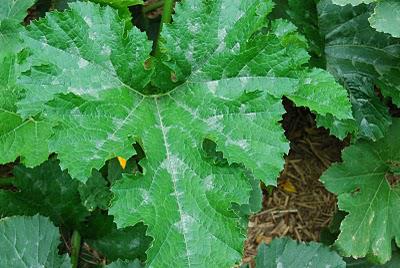 I thought I would finish off with a few words in favour of powdery mildew, such as this stuff on my zucchini leaves.
I thought I would finish off with a few words in favour of powdery mildew, such as this stuff on my zucchini leaves.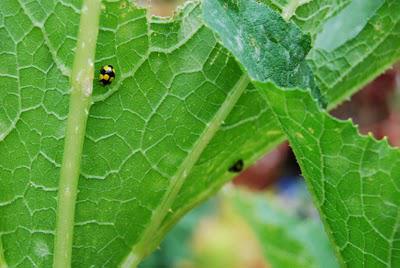 The more powdery mildew you have the more ladybirds the plants attract. My zucchini foliage last year was covered in ladybirds, so every cloud has a silver lining, as they say.
The more powdery mildew you have the more ladybirds the plants attract. My zucchini foliage last year was covered in ladybirds, so every cloud has a silver lining, as they say.Here's one more option for you to try, if a $19.85 jar of stuff sounds a bit too expensive for you. An expert gardener to whom I was speaking on Saturday night (at an excellent party hosted by Zora and Sean - well done, you two) told me that she puts the well-known seaweed product Seasol into her sprayer and uses that to control powdery mildew in her vegie garden. So if you have a bottle of that on hand already, give that a try and let me know if that works for you. You might save some other gardeners some money, some heartache and most important of all, some crops.If you want to read a bit more about Eco Fungicide, here's a link to their website.
